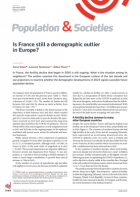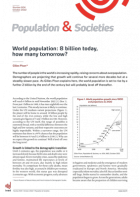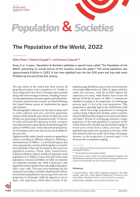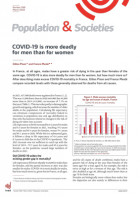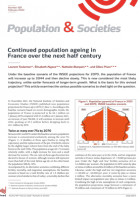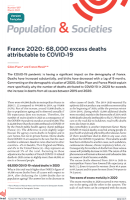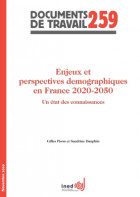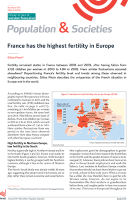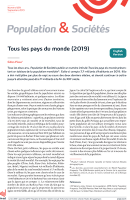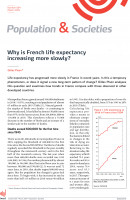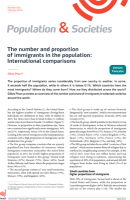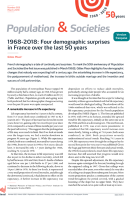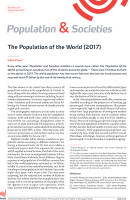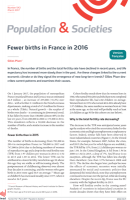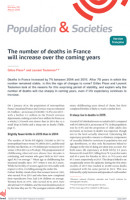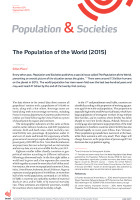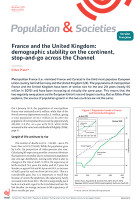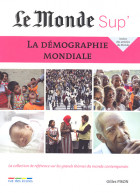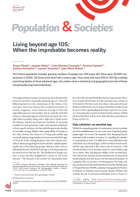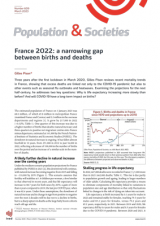
France 2022: a narrowing gap between births and deaths
Population and Societies
n° 609, March 2023
https://doi.org/10.3917/popsoc.609.0001
French National Museum of Natural History; Institut national d’études démographiques (INED), F-93300 Aubervilliers, France
Natural increase—the difference between births and deaths—fell fourfold in France between 2012 and 2022, reflecting a 100,000 decrease in the number of births over the last 10 years and a similar increase in the number of deaths. Life expectancy has stagnated over the last 3 years due to the COVID-19 pandemic combined with excess mortality in 2022 linked to several summer heatwaves and a seasonal flu epidemic at the end of the year. It appears that while COVID-19 had little impact on births, it temporarily modified their seasonality.
births, deaths, fertility, life expectancy, mortality, mortality crisis, COVID-19, influenza, heatwave, natural increase, seasonality of births, France
Table of contents
- Appendix A References
1.
Three years after the first lockdown in March 2020, Gilles Pison reviews recent mortality trends in France, showing that excess deaths are linked not only to the COVID-19 pandemic but also to other events such as seasonal flu outbreaks and heatwaves. Examining the projections for the next half-century, he addresses two key questions: Why is life expectancy increasing more slowly than before? And will COVID-19 have a long-term impact on births?
The estimated population of France on 1 January 2023 was 68.0 million, of which 65.8 million in metropolitan France (mainland France and Corsica) and 2.2 million in the overseas departments and regions [1]. It grew by 217,000 in 2022 (+0.32%; Table 1). One-quarter of this increase was due to a higher number of births than deaths (natural increase) and three-quarters to positive net migration (entries into France minus departures, estimated at 161,000 by the French National Institute of Statistics and Economic Studies [INSEE]). The slowdown in natural increase is ongoing. It has fallen almost fourfold in 10 years, from 251,000 in 2012 to just 56,000 in 2022, reflecting a decrease of 100,000 in the number of births over the period and an increase of a similar scale in the number of deaths.
1.1. A likely further decline in natural increase over the coming years
Under the medium scenario population projections for France published by INSEE in 2021 [2], this downtrend will continue, with natural increase becoming negative from 2035 and falling to –110,000 by 2070 (Figure 1). This scenario assumes that fertility will stabilize at 1.8 children per woman, a level similar to that observed in recent years, and that life expectancy will increase to 88.7 years for both sexes by 2070, a gain of more than 6 years compared to 2019, the last pre-COVID year, when it was 82.6 years. Under these assumptions, the slowdown of natural increase and its change in sign from positive to negative over the next 2 decades will be due not to a decline in births, but to a sharp upturn in deaths as the large baby boom cohorts reach old age and die.
1.2. Stalling progress in life expectancy
In 2022, 667,000 deaths were recorded in France [1], 5,000 more than in 2021 (662,000 deaths; Table 1). This rise is due partly to population growth and ageing, leading to larger numbers of older adults. Calculating life expectancy provides a means to eliminate components of mortality linked to variations in population size and age distribution so that only fluctuations linked to changes in the risk of dying are taken into account.
Life expectancy at birth increased by 0.1 years for males in 2022 and remained stable for females, reaching 79.3 years for males and 85.2 years for females, versus 79.2 years and 85.2 years, respectively, in 2021. Between 2019 and 2020, life expectancy fell by 0.6 years for males and 0.5 years for females due to the COVID-19 pandemic. Between 2020 and 2021, it started increasing again, but by just 0.1 years for both men and women. Improvements in 2021 and 2022 were too small to make up for the drop observed since 2019, when life expectancy was 79.7 years for men and 85.6 years for women.
Viewed in relation to the long-term trends observed since 1994, the recent annual life expectancy fluctuations show that progress is slowing (Figure 2). For what reason? Has life expectancy reached a ceiling?
1.3. Why is life expectancy progressing more slowly now?
The stagnation of life expectancy over the last 3 years is due mainly to the COVID-19 pandemic. It caused thousands of deaths in 2020, but also in 2021 and 2022 across successive waves of the pandemic (Figure 3). While the vaccination programme that began at the end of 2020 reduced the risk of death, overall mortality remained higher than normal. Severe winter flu epidemics also slowed down the increase in life expectancy. France has been struck by five such epidemics since 2014, during the winters of 2014–2015, 2016–2017, 2017–2018, 2018–2019, and 2022–2023.
Around 20,000 excess deaths, mainly of older adults, were recorded in the winters of 2016–2017 and 2017–2018, and 12,000 in the winter of 2018–2019 [3, 4, 5]. Of these excess deaths, it is estimated that around 70% are directly attributable to influenza, i.e. 14,000 deaths in 2016–2017, a similar number in 2017–2018, and 8,000 in 2018–2019 [3].
Extreme weather may also be deadly, as observed during the three summer heatwaves of 2022. The resulting excess mortality, combined with that of COVID-19 and influenza—which struck twice in 2022, first in late winter and early spring, and then at the end of the year—probably explain the stagnation of life expectancy in 2022.
Beyond the effects of periodic epidemics and heatwaves, it is still too early to determine whether long-term life expectancy trends have been affected by a slowdown in progress linked to other factors.
1.4. Fewer births in 2022 than in 2021
With 723,000 births in 2022 versus 742,000 in 2021, the number of births in France is decreasing, as is the total fertility rate, which stood at 1.80 children per woman in 2022, down from 1.84 in 2021 (Figure 4).
The postponement of childbearing observed over 4 decades is continuing; the women who gave birth in 2022 were aged 31.0 years on average (29 years at first birth). Mean age at childbearing has been increasing steadily since 1977, when it was 26.5 years.
Cohort fertility trends show that the women born in 1972, who turned 50 in 2022 and who have now completed their reproductive life, had 1.99 children on average. Women born in 1982 who turned 40 in 2022 already have 1.99 children, more than their elders born in 1972 at the same age, so the total will probably reach at least 2.0 children at age 50 for this cohort.
1.5. Has COVID-19 affected births?
The number of births has been falling since 2010 (Figure 1). Has the COVID-19 pandemic modified this trend? During the first lockdown, from 17 March to 11 May 2020, some predicted a baby boom 9 months later, arguing that couples would take advantage of restrictions on movement and more time together at home to start a family or have another child.
In fact, the number of conceptions decreased. There were 7% fewer births in December 2020—corresponding to conceptions in March 2020 at the start of the first lockdown or just before—than in December 2019 (Figure 5). Likewise, there were 13% fewer births in January 2021—corresponding to conceptions in April 2020 in the midst of the first lockdown—than in January 2020. Births in February 2021 of children conceived in May 2020 at the end of the lockdown or just afterwards, were down by 5% over the previous February. In subsequent months, however, births were generally more numerous than in the equivalent months of 2020, making up for the shortfall earlier in the year. By the end of 2021, births in the year slightly outnumbered those of 2020 (7,000 more births).
The decrease in conceptions during the first lockdown illustrates a phenomenon often observed at times of economic crisis, when certain couples decide to postpone their childbearing plans in the face of rising unemployment and uncertainty about the future [6]. But a catch-up effect is observed once the crisis is over.
This is what happened after the first lockdown, and birth numbers soon started rising again. The second lockdown, from late October to mid-December 2020, does not seem to have affected conceptions and did not hold back the recovery in births. It was less strict than the first, and couples wanting a child may have made up for lost time after realizing that the pandemic would last longer than first imagined. The impact of the third lockdown in April 2021, which lasted under a month, appears to be minimal. A slight dip in births occurred 9 months later, in January 2022, followed by a temporary uptick the following month, in February 2022 (Figure 5).
1.6. A change in the seasonality of births
Generally, there are slightly more births in summer, between July and October, and slightly fewer in winter and early spring, from December to April, as illustrated by the monthly variations in 2019, which follow the usual pattern (Figure 5). This is due to a higher frequency of conceptions in autumn and a lower frequency in the spring.
The COVID-19 pandemic and the first lockdown accentuated and brought forward the spring dip in conceptions in 2020, producing a large shortfall in births 9 months later (Figure 5). The subsequent recuperation amplified and prolonged the peak in conceptions in the autumn of 2020, affecting the seasonality of births over the following 9 months up to the end of winter 2021–2022. Seasonality then appears to have resumed its normal pattern against a backdrop of declining births since 2010 (Figures 1 and 4).
While the COVID-19 pandemic had little impact on the general downtrend in births, it temporarily modified their seasonality.
Appendix A References
-
[1] Papon S., 2023, L’espérance de vie stagne en 2022 et reste inférieure à celle de 2019, Insee Première, 1935. https://www.insee.fr/fr/statistiques/6687000
-
[2] Algava É., Blanpain N., 2021, Projections de population 2021-2070 pour la France. Résultats et pyramides des âges, Insee Résultats. https://www.insee.fr/fr/statistiques/5760764
-
[3] Équipes de surveillance de la grippe, 2019, Surveillance de la grippe en France, saison 2018-2019, Bulletin épidémiologique hebdomadaire, 28, 552–563. http://beh.santepubliquefrance.fr/beh/2019/28/2019_28_1.html
-
[4] Santé publique France, 2020, Bulletin épidémiologique de la grippe. Bilan de la surveillance, saison 2019-2020. https://www.santepubliquefrance.fr/maladies-et-traumatismes/maladies-et-infections-respiratoires/grippe/documents/bulletin-national/bulletin-epidemiologique-grippe.-bilan-de-la-surveillance-saison-2019-2020
-
[5] Santé publique France, 2023, Surveillance sanitaire de la mortalité toutes causes confondues. https://www.santepubliquefrance.fr/surveillance-syndromique-sursaud-R/bulletins-sursaud-R-sos-medecins-oscour-mortalite
-
[6] Pison G., 2011, Two children per woman in France in 2010: Is French fertility immune to economic crisis? Population & Societies, 476. https://www.cairn-int.info/journal-population-and-societies-2011-3-page-1.htm
Natural increase—the difference between births and deaths—fell fourfold in France between 2012 and 2022, reflecting a 100,000 decrease in the number of births over the last 10 years and a similar increase in the number of deaths. Life expectancy has stagnated over the last 3 years due to the COVID-19 pandemic combined with excess mortality in 2022 linked to several summer heatwaves and a seasonal flu epidemic at the end of the year. It appears that while COVID-19 had little impact on births, it temporarily modified their seasonality.
Cite the article
Gilles Pison, France 2022: a narrowing gap between births and deaths, 2023, Population and Societies, no. 609
 This document may be reproduced free of charge on paper or online using our Creative Commons licence.
This document may be reproduced free of charge on paper or online using our Creative Commons licence.

